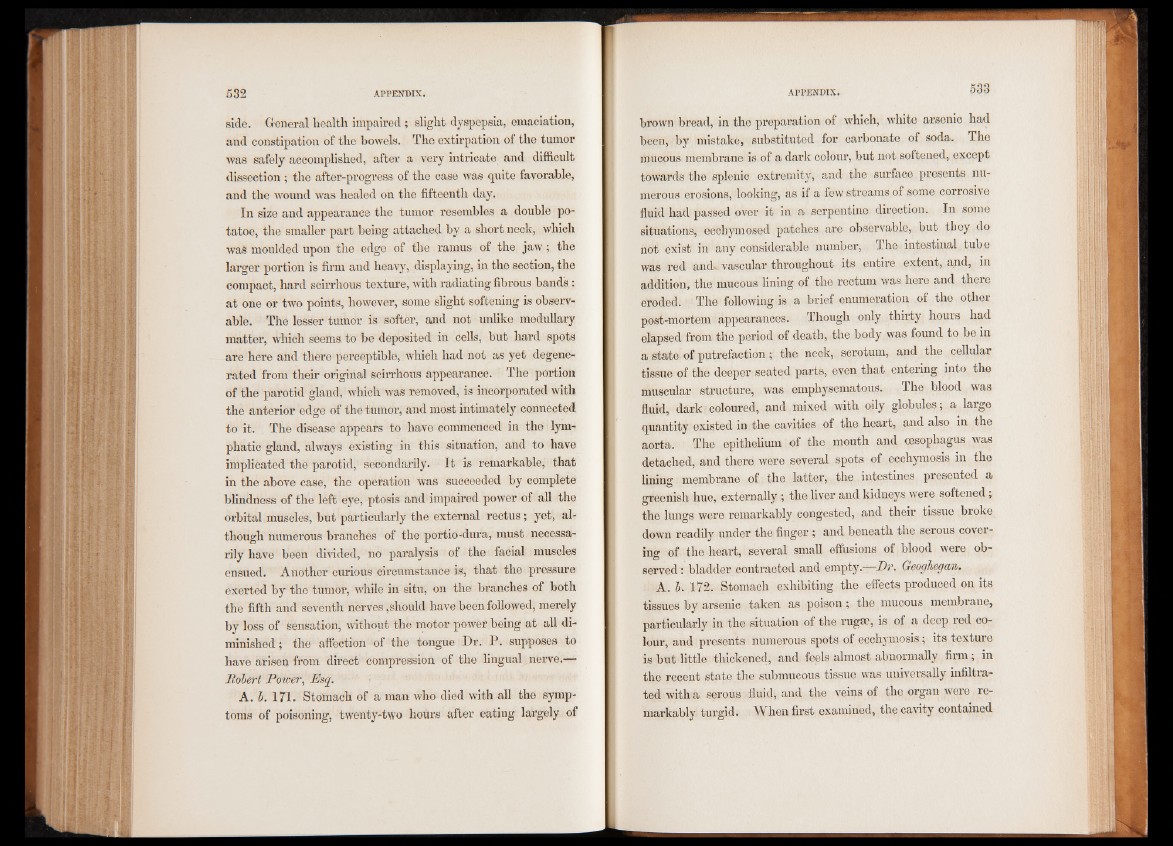
side. General health impaired ; slight dyspepsia, emaciation,
and constipation of the bowels. The extirpation of the tumor
was safely accomplished, after a very intricate and difficult
dissection; the after-progress of the case was quite favorable,
and the wound was healed on the fifteenth day.
In size and appearance the tumor resembles a double po-
tatoe, the smaller part being attached by a short neck, which
was moulded upon the edge of the ramus of the jaw; the
larger portion is firm and heavy, displaying, in the section, the
compact, hard scirrhous texture, with radiating fibrous bands:
at one or two points, however, some slight softening is observable.
The lesser tumor is softer, and not unlike medullary
matter, which seems to be deposited in cells, but hard spots
are here and there perceptible, which had not as yet degenerated
from their original scirrhous appearance. The portion
of the parotid gland, which was removed, is incorporated with
the anterior edge of the tumor, and most intimately connected
to it. The disease appears to have commenced in the lymphatic
gland, always existing in this situation, and to have
implicated the parotid, secondarily. It is remarkable, that
in the above case, the operation was succeeded by complete
blindness of the left eye, ptosis and impaired power of all the
orbital muscles, but particularly the external rectus; yet, although
numerous branches of the portio-dura, must necessarily
have been divided, no paralysis of the facial muscles
ensued. Another curious circumstance is, that the pressure
exerted by the tumor, while in situ, on the branches of both
the fifth and seventh nerves,should have been followed, merely
by loss of sensation, without the motor power being at all diminished
; the affection of the tongue Dr. P. supposes to
have arisen from direct compression of the lingual nerve.—
Robert Power, Esq.
A. 1. 171. Stomach of a man who died with all the symptoms
of poisoning, twenty-two hours after eating largely of
brown bread, in the preparation of which, white arsenic had
been, by mistake, substituted for carbonate of soda. The
mucous membrane is of a dark colour, but not softened, except
towards the splenic extremity, and the surface presents numerous
erosions, looking, as if a few streams of some corrosive
fluid had passed over it in a serpentine direction. In some
situations, eccbymosed patches are observable, but they do
not exist in any considerable number, The intestinal tube
was red and^ vascular throughout its entire extent, and, in
addition, the mucous lining of the rectum was here and there
eroded. The following is a brief enumeration of the other
post-mortem appearances. Though only thirty hours had
elapsed from the period of death, the body was found to be in
a state of putrefaction; the neck, scrotum, and the cellular
tissue of the deeper seated parts, even that entering into the
muscular structure, was emphysematous. The blood was
fluid, dark coloured, and mixed with oily globules; a large
quantity existed in the cavities of the heart, and also in the
aorta. The epithelium of the mouth and oesophagus was
detached, and there were several spots of ecchymosis in the
lining membrane of the latter, the intestines presented a
greenish hue, externally ; the liver and kidneys were softened,
the lungs were remarkably congested, and their tissue broke
down readily under the finger ; and beneath the serous covering
of the heart, several small effusions of blood were observed
: bladder contracted and empty.—Dr. Geoghegan.
A. b. 172. Stomach exhibiting the effects produced on its
tissues by arsenic taken as poison; the mucous membrane,
particularly in the situation of the rugae, is of a deep red colour,
and presents numerous spots of ecchymosis; its texture
is but little thickened, and feels almost abnormally firm; in
the recent state the submucous tissue was universally infiltrated
with a serous fluid, and the veins of the organ were remarkably
turgid. When first examined, the cavity contained